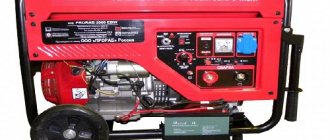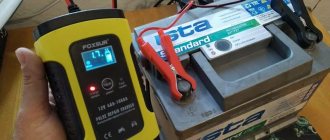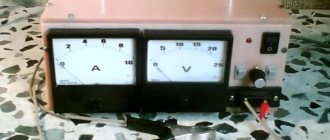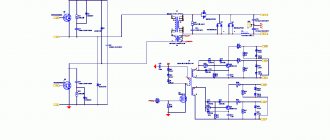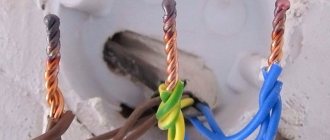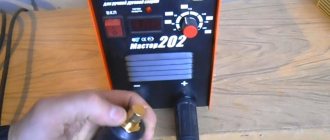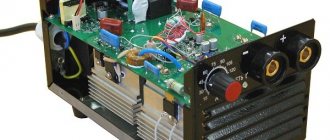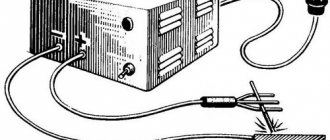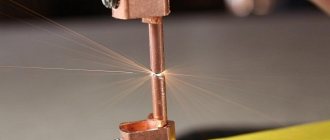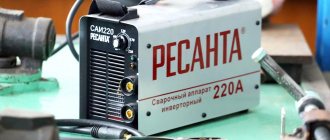Home » Useful tips » Homemade products » How to make a welding machine from a car battery
In the life of every man, a situation may arise when he needs to perform a small amount of welding work, but there is no welding machine at hand. As a rule, in such a situation, many people fall into despair, because they believe that there is currently no alternative to a welding machine. Of course, there is no alternative, you cannot make a welding machine from car batteries, it will not completely replace standard installations, but a small amount of work will help get it done.
Do-it-yourself welding machine from car batteries
Do-it-yourself welding machine for welding small parts
Quite often in the practice of any owner, the need arises to connect metal parts. One such connection method is welding. But what to do if you don’t have a welding machine? Of course, you can buy it, but you can also make the simplest device yourself, and in almost half an hour.
Prologue
The simplest prototype of a welding machine - a lighting electric arc projector - was used back in the mid-twentieth century in film studios during the filming of films.
At home, it is possible to make a simple, rare homemade welding machine from a 200 W autotransformer. (An approximate diagram of an autotransformer is shown in the figure). The output voltage is regulated by rearranging the television plug in the sockets.
On the secondary winding of the transformer, you need to find two terminals at which the voltage will be about 40 V. All that remains is to connect the graphite electrodes to these terminals and the welding machine is ready! However, it must be taken into account that when using such an autotransformer for welding purposes, it is advisable to have a good knowledge of the basics of electrical safety, since galvanic isolation from the electrical network is not ensured.
The scope of application of such a homemade welding machine is quite wide: from welding metal products to hardening the working surfaces of the tool.
Examples of Voltaic Arc Applications
In the practice of radio amateurs, at times there is a need to weld or very strongly heat small parts. In such cases, there is no need to use a serious welding machine, because... To create high-temperature plasma it is not necessary to have special equipment.
Let's look at several examples of the practical application of the Voltaic Arc.
Welding filament magnetron with power buses
In this case, welding is simply necessary, although many, when faced with such a difficulty, replace the magnetron. But most often there are only two malfunctions: the filament breaks at the point (item 1) and the feed-through capacitors (item 2) fail due to breakdown.
The picture shows a magnetron from a Kenwood microwave oven, which worked after repair for more than twenty years.
DIY thermocouple repair
Of course, making a thermocouple is a completely hopeless task, but it happens that it needs to be repaired if the “ball” breaks. Typically, such thermocouples are found in multimeters that have a temperature measurement mode
Heating High Carbon Steel
If it is necessary to change the shape of the spring or make a hole, it should be taken into account that the hardened spring is too hard for drilling and too brittle for making a hole with a punch.
And in the case of hardening a steel tool (made from tool steel), it is enough to heat the working surface to a crimson color and cool it in a bath with machine oil. The figure shows a hardened screwdriver blade after machining the working edge.
How to get a Voltaic Arc?
Small welding work can be performed using a transformer with a power of 200 watts and an output voltage in the range from 30 to 50 volts. In this case, the welding current should be 10-12 Amps. There is no need to worry about the transformer overheating, since the arc burns only for a short time.
An ordinary laboratory autotransformer LATR with a current of 9 Amperes is also suitable. However, the full extent of the danger must be taken into account due to the fact that there is no galvanic isolation from the electrical network.
In order to prevent damage to the graphite roller of the LATR current collector, it is advisable to limit the input current by using a fuse. Then an accidental short circuit in the electrode circuit is no longer scary.
Electrodes can be any graphite rods of simple pencils (preferably soft).
The metal part of the electrical terminal block is used as a holder for the lead.
This figure shows an example of a holder using a terminal block, with one hole used to attach the handle, and the second to clamp the lead into the terminal.
In order to prevent melting of the disposable syringe (item 3) when the terminal block (item 1) is heated, fiberglass washers (item 2) are used. And for a standard connection to the cable, you can use the standard socket from the device (pos. 4).
So, the connection diagram is quite simple: one terminal of the secondary winding is connected to the holder, and the second terminal is connected to the part being welded.
There is another option for attaching the electrode holder using an electrical terminal. The second holder will be needed in case of welding metal products with the same melting point or if it is necessary to heat the metal product (hardening, changing shape).
Diagram for connecting two graphite electrodes to the secondary winding of a transformer.
To protect your eyes from corneal burns and from sparks, it will not be enough to use dark glasses due to the low density of light filters. The following device can be made: the frame of binocular glasses with the lenses removed can serve as a shield; The filter is attached using a stationery clip. Or you can use amateur radio glasses used in SMD technologies.
When welding copper with nichrome or steel, you will need flux. When a small amount of water is added to sodium tetraborate (borax) or boric acid, a paste is obtained, which is used to lubricate the welding areas.
The materials for making flux can usually be found at a hardware store. You can also use Borax insect repellent containing boric acid.
Introductory information
In theory, everything seems much simpler. But in application, certain conditions must be met. The current in the electrical network must remain uninterrupted and not fall below 180 Volts.
Or your welding unit must cope with low voltage work. Such equipment is not cheap.
It is not even discussed that you must have access to electricity. But some country houses and dachas, garages located far from the urban area are not connected to electricity.
What to do in this case. Our opinion comes down to buying a fuel generator for welding. But not everyone wants to spend extra money, especially if you rarely use welding.
The correct option under such circumstances is to use a 12-volt car battery. Some specialists manage to connect the battery to a welding inverter.
Even to carry out non-long-term welding. In our review we will write whether it is possible to carry out welding tasks using a 12 Volt battery. Is it really necessary to take such risks?
DIY welding transformer
The assembly of the transformer version will be slightly different from the previous one. This unit operates on alternating current, but for welding with direct current you need to assemble a simple attachment for it.
To work, you will need transformer iron for the core, as well as several tens of meters of thick wire or thick copper busbar. All this can be found at the metal collection point. The core is best made U-shaped, toroidal or round. Many also take the stator from an old electric motor.
The assembly instructions for the U-shaped core look like this:
- Take transformer iron with a cross-section from 30 to 55 cm2. If the figure is higher, the device will be too heavy. And if the cross section is less than 30, the device will not be able to work correctly.
- Take a copper winding wire with a cross-section of about 5 mm 2, equipped with heat-resistant fiberglass or cotton insulation. Insulation is important because during operation the winding can heat up to 100 degrees or more. The winding wire has a square or rectangular cross-section. However, such an option is difficult to find. An ordinary one with a similar cross-section will do, but you will only need to remove the insulation from it, wrap it in fiberglass and thoroughly soak it with electrical varnish, and then dry it. The primary winding has 200 turns.
- The secondary winding will require about 50 turns. There is no need to cut the wire. Connect the primary winding to the network, and on the secondary wires find a place where the voltage is about 60 V. To find such a point, unwind or wind additional turns. The wire can be aluminum, but the cross-section must be 1.7 times larger than for the primary winding.
- Install the finished transformer into the housing.
- To bring out the secondary winding, copper terminals are required. Take a tube with a diameter of 10 mm and a length of about 4 cm. Rivet its end and drill a hole with a diameter of 10 mm, and insert the end of the wire, previously cleared of insulation, into the other end. Next, crimp it with light hammer blows. To strengthen the contact of the wire with the terminal tube, apply notches to it with a core. Screw homemade terminals to the body with nuts and bolts. It is best to use copper parts. When winding the secondary winding, it is advisable to make taps every 5-10 turns, they will allow you to change the voltage on the electrode in steps;
- To make an electrical holder, take a pipe with a diameter of about 20 mm and a length of about 20 cm. At the ends, about 4 cm from the end part, cut out recesses to half the diameter. Insert the electrode into the recess and press it with a spring based on a welded bush of steel wire with a diameter of 5 mm. Attach the same wire that was used for the secondary winding to the second terminal using a nut and screw. Place a rubber tube with a suitable inner diameter onto the holder.
It is best to connect the finished device to the network using wires with a cross-section of 1.5 cm2 or more, as well as a switch. The current in the primary winding usually does not exceed 25 A, and in the secondary winding it fluctuates between 6-120 A. When working with electrodes with a diameter of 3 mm, stop every 10-15 to allow the transformer to cool down . If the electrodes are thinner, this is not necessary. More frequent breaks are needed if you are working in cutting mode.
Do-it-yourself mini-welding
To assemble a miniature welding machine yourself, you will only need a few hours and the following materials:
- graphite rod from an old battery;
- side cutters or pliers;
- knife;
- dry rag;
- sandpaper;
- gloves;
- 20 cm of wire with a diameter of 5 mm made of aluminum or copper;
- 6 cm of PEV 0.5 copper wire;
- insulating tape;
- stranded wire;
- any metal clamp;
- a transformer from a microwave power supply with a rectifier, or an old TV or receiver.
Advantages
It is not for nothing that laser welding of jewelry has become widespread among other methods of joining metal. This was facilitated by the following number of advantages:
- The joint seam is almost invisible, therefore, the product can create the appearance of a solid cast piece;
- Work can be carried out even with the thinnest delicate products, which is not always possible with other types of welding;
- Repairing and creating new products is not difficult if you have experience;
- The equipment has a fairly large range of parameter adjustments, which makes it possible to easily select the desired operating mode;
- You can work with precious metals without unnecessary problems when joining, as happens with other welding methods for difficult-to-weld metals;
- The welding speed is quite high;
- The productivity of the process significantly exceeds alternative methods.
Flaws
This technique also has some disadvantages that do not allow it to be used in all jewelry workshops;
- The cost of a laser machine is quite high, so not every master can afford it;
- Working with the technology requires experience, since it has some specifics and requires taking into account a lot of nuances;
- Work is carried out only with metals, while other types of materials are not suitable for this.
Technology
Welding jewelry made of brass at home, as well as other types of metal using a laser, has almost the same operating principle. Regardless of which installations are used for this, the rules for carrying out the process are the same almost everywhere. This requires strict adherence to technology, which involves both preparation and direct temperature treatment.
The metal surface should be cleaned of dirt, grease films and other unnecessary things and deposits. This can ruin the metal joint, since everything in this area should be as clean as possible. Almost all connections are made end-to-end, especially when it comes to repairs. Here one part of the part is connected to another, since the spectrum of laser action is very narrow.
The joining process can be with or without solder. Most often, the workpiece is held in the hands and brought at the connection point to the laser itself.
The installation is configured to the desired mode and turned on. In just a few seconds of exposure to the welding site, the metal begins to soften and melt. If solder is used, it first melts and envelops the joint.
The thinner the part, the less exposure time it requires to weld.”
At the very beginning, the seam may become rough and the joint will be noticeable. You can correct the position using the same laser, since immediately after joining you can smooth out the joints so that the metal turns into a flat surface.
Post-processing is not required very often. Specialists who have sufficient experience can repair jewelry that does not require further modification. Otherwise, you need to remove a small layer with sandpaper, so that the product will look the same as a new decoration.
We make welding machines with our own hands
Welding work at home has long become commonplace. Availability of equipment and consumables, the opportunity to inexpensively attend welding courses, various training manuals for acquiring independent skills. All these factors make it possible to save on the labor costs of a professional welder and increase the efficiency of work.
However, if you carefully study the welding machine market, unpleasant aspects become clear:
- High-quality welders have a high cost; it is more profitable to hire a specialist several times (unless, of course, you do this work constantly).
- Affordable units have a number of disadvantages: low reliability, poor seam quality, dependence on the supply voltage and type of consumables.
Hence the conclusion: if you need high quality equipment at an affordable price, you will have to make a welding machine from available materials with your own hands.
Before considering options for homemade welders, let’s look at the principle of their operation.
The operation of any unit is based on Ohm's law. At constant power, there is an inverse relationship between current and voltage. For normal operation, a current of 60–150 A is required. Only in this case will the metal in the welding zone melt. Let's imagine a welding machine that operates directly with a voltage of 220 volts. To achieve the required current, a power of 15–30 kW will be required. Firstly, for this it will be necessary to lay a separate power supply line: most inputs into residential premises are limited by technical conditions at the level of 5–10 kW. In addition, such a current will require wiring with a cross-section of at least 30 mm². You will have to cook in compliance with protective measures when working in electrical installations up to 1000 volts: rubber boots, gloves, work area fencing, etc.
Of course, it is impossible to ensure such conditions in reality.
Therefore, any welding machine converts the voltage (downward): at the output we obtain the desired current while maintaining reasonable power.
The optimal voltage value is 60 volts. With a welding current of 100 A, this is a completely acceptable 6 kW of power. How to convert voltage?
There are four main types of welding machines
- Transformer. The device operates on alternating current. The main unit is no different from a conventional power supply: the input is 220 volts, the output is the required 60 volts. Due to the possibility of mechanical movement of the secondary winding along the core, the value of the operating current changes.
Advantages: simplicity and low cost of design, maintainability. Disadvantages: large size and weight, alternating current leads to unstable formation of the weld, highly qualified specialist is required for work. - Rectifier. Essentially, this is the same transformer, only with a diode (thyristor) rectifier in the secondary winding circuit.
After converting the voltage through a transformer (with a traditional mechanical current regulator), the secondary AC voltage is rectified in one of the following ways. In primitive (inexpensive) designs, a diode bridge is used. More advanced circuits operate on a thyristor circuit, with the ability to adjust parameters. Advantages: stable welding parameters, the ability to work with various metals, no highly qualified craftsman required. Disadvantages: higher cost, difficulty in repair and maintenance. Some craftsmen convert a simple transformer welder into DC apparatus. To do this, you just need to assemble a powerful rectifier and connect it to the output of the secondary winding. This will require powerful diodes (assembling a bridge) and radiators to dissipate heat.
A common drawback of the considered schemes is the dependence of the output parameters on the quality of the electrical network. If there are voltage sags (this is normal during welding), the characteristics of the output voltage and current change. As a result, the quality of the weld seam suffers. Therefore, manual adjustment of the current strength (by moving the windings) is mandatory.
- Semi-automatic This is an advanced version of the rectifier, with a device for mechanically feeding welding wire into the work area. Welding is carried out in an inert gas environment; a gas cylinder is required to complete the work. Advantages: high-quality weld, no need for special training of the craftsman. Disadvantages: additional equipment required (gas cylinder), high cost.
- Inverter. Today, it is the most common welder among amateurs. An inverter power supply with PWM control is used as a voltage converter. This technology has now become accessible, which has a positive effect on the cost. Advantages: even a novice welder can operate the device, compact size, light weight. Disadvantages: not very high reliability, difficult to repair.
Any of the listed devices can be assembled independently. Let's review manufacturing technologies by model:
Application area
Laser jewelry welding, as the name suggests, is used in the jewelry industry. It is mainly used for repairing and creating new products. From time to time, jewelry may break due to careless wearing, accidental impacts, falls and other cases. Chains break, pendants break at the junction, and rings periodically burst. To fix them, you need special equipment. Soldering technology is simpler and more accessible, but it leaves more marks and requires additional processing after connection. It also requires the use of solder, whereas welding provides everything you need more efficiently and reliably, after which no solder admixture is added to the metal.
Jewelry manufacturing also requires the use of lasers, as they can create bonds that are virtually undetectable. New jewelry will look almost seamless if you choose the right modes. It is also worth noting the simplified work with precious metals, where the complexity of welding certain metals is reduced to a minimum.
Transformers (with or without rectifier)
The heart of a transformer is the core. It is assembled from transformer steel plates, which are quite problematic to make by hand. By hook or by crook, the source material is extracted at factories, construction teams, and scrap metal collection points. The resulting structure (usually in the form of a rectangle) must have a cross-section of no less than 55 cm². This is a rather heavy structure, especially after laying the windings.
During assembly, it is imperative to provide an adjusting screw, with which you can move the secondary winding relative to the stationary primary.
In order not to go into the complexity of calculating the cross-section of wires, we will take typical parameters:
Based on this, the cross-section of the primary wire should be at least 5 mm²; if you do it with a margin, you can take a wire of 6–7 mm². The insulation must be heat-resistant and made from a material that does not support combustion.
Inverter (pulse power supply for welding)
A homemade inverter welding machine cannot be made simply “on the knee”. This will require a modern element base and experience in repairing and creating electronic devices. However, the scheme is not as scary as it is made out to be. There are a great many similar devices made, and they all work no worse than their factory counterparts. In addition, to create a pulse welding machine with your own hands, it is not necessary to purchase dozens of expensive radio components and ready-made components. Most of them, especially high-frequency elements for the power supply, can be borrowed from old TVs or power supplies from a computer. The cost is close to zero.
The inverter in question has the following characteristics:
- Load current on the electrodes: up to 100 A.
- Power consumption from a 220 volt network is no more than 3.5 kW (current about 15 A).
- Used electrodes up to 2.5 mm.
The illustration shows a finished circuit, which has been repeatedly tested by many home craftsmen.
Structurally, the inverter consists of three elements:
- Power supply for the converter and control circuit. Made on an accessible element base, using an optocoupler from an old computer power supply. When making a transformer yourself, the cost is almost zero: the parts are cheap. The values and names of radioelements are shown in the illustration.
- Capacitor charge delay unit (for starting arc). Made on the basis of KT972 transistors (absolutely not a shortage). Of course, transistors are installed on radiators. For switching, an ordinary automotive relay with a current load on the contacts of up to 40 A is sufficient. For manual control, ordinary circuit breakers (packets) of 25 A are installed. Output 300 volts - idle. At load the voltage is 50 volts.
- The current transformer is the most critical component. During assembly, special attention should be paid to the accuracy of the inductors. Some adjustment can be made using a variable resistor (highlighted in red in the diagram). However, if the parameters are not consistent, the required arc power will not be achieved. PWM is implemented on the US3845 chip (one of the few parts that will have to be purchased). Power transistors are the same KT972 (973). Some elements in the diagram are imported, but they can easily be replaced with available domestic ones by searching for analogues on the datasheet website. The high-frequency unit is made from parts of a line transformer from a TV.
Working wires no longer than 2 meters are connected to the output of the welding inverter. The cross-section is at least 10 squares. When working with electrodes up to 2.5 mm, the current drop is minimal, the seam is smooth and even. The arc is continuous, no worse than the factory equivalent.
If there is active cooling (fans from the same computer power supply), the design can be compactly packed into a small case. Considering high-frequency converters, it is better to use metal.
The more complex the homemade welding machine, the greater the savings. It is simple transformers that are more expensive due to the use of expensive copper in the windings or transformer iron. Switching power supplies, especially if you have old parts from standard electrical appliances in stock, are practically free.
Own experience of cooking from a car battery
We will look at our own experience of using a car battery to power an inverter unit. You can test it yourself and duplicate our work to verify what you have received.
It should be noted that one regular car battery will not be enough. Know this is a fact. At first we wanted to power the inverter from one car battery.
Welding was carried out at low current, using electrical connections 2 mm thick. The arc hardly ignited. The seam went with considerable effort. Then they took out two car batteries and connected them one by one.
